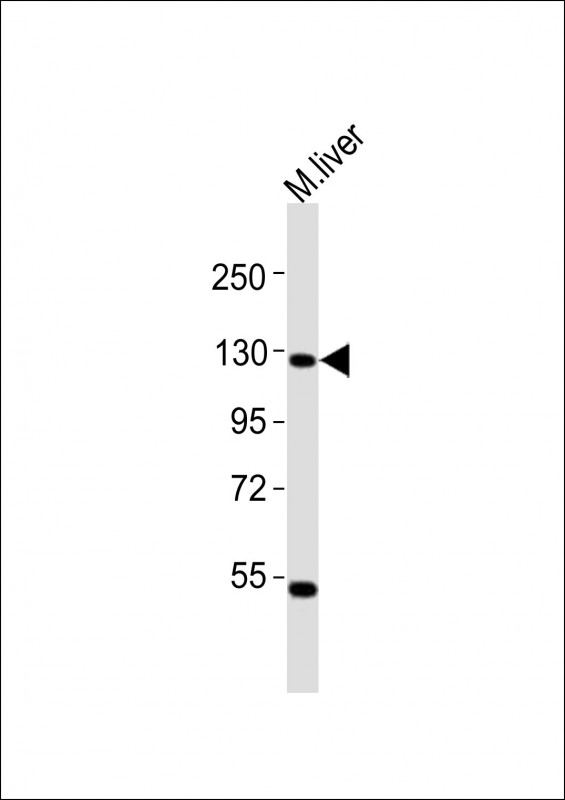Mouse Jarid2 Antibody (Center)
Purified Rabbit Polyclonal Antibody (Pab)
- 产品详情
- 实验流程
- 背景知识
Application
| WB, E |
|---|---|
| Primary Accession | Q62315 |
| Reactivity | Mouse |
| Host | Rabbit |
| Clonality | polyclonal |
| Isotype | Rabbit IgG |
| Calculated MW | 137445 Da |
| Gene ID | 16468 |
|---|---|
| Other Names | Protein Jumonji, Jumonji/ARID domain-containing protein 2, Jarid2, Jmj |
| Target/Specificity | This Mouse Jarid2 antibody is generated from a rabbit immunized with a KLH conjugated synthetic peptide between 435-468 amino acids from the Central region of Mouse Jarid2. |
| Dilution | WB~~1:2000 E~~Use at an assay dependent concentration. |
| Format | Purified polyclonal antibody supplied in PBS with 0.09% (W/V) sodium azide. This antibody is purified through a protein A column, followed by peptide affinity purification. |
| Storage | Maintain refrigerated at 2-8°C for up to 2 weeks. For long term storage store at -20°C in small aliquots to prevent freeze-thaw cycles. |
| Precautions | Mouse Jarid2 Antibody (Center) is for research use only and not for use in diagnostic or therapeutic procedures. |
| Name | Jarid2 |
|---|---|
| Synonyms | Jmj |
| Function | Regulator of histone methyltransferase complexes that plays an essential role in embryonic development, including heart and liver development, neural tube fusion process and hematopoiesis (PubMed:10807864, PubMed:12852854, PubMed:12890668, PubMed:15542826, PubMed:15870077, PubMed:19010785, PubMed:20064375, PubMed:20064376, PubMed:20075857). Acts as an accessory subunit for the core PRC2 (Polycomb repressive complex 2) complex, which mediates histone H3K27 (H3K27me3) trimethylation on chromatin (PubMed:20064375, PubMed:20064376). Binds DNA and mediates the recruitment of the PRC2 complex to target genes in embryonic stem cells, thereby playing a key role in stem cell differentiation and normal embryonic development (PubMed:20064375, PubMed:20075857). In cardiac cells, it is required to repress expression of cyclin-D1 (CCND1) by activating methylation of 'Lys-9' of histone H3 (H3K9me) by the GLP1/EHMT1 and G9a/EHMT2 histone methyltransferases (PubMed:12852854, PubMed:12890668, PubMed:19010785). Also acts as a transcriptional repressor of ANF via its interaction with GATA4 and NKX2-5 (PubMed:15542826). Participates in the negative regulation of cell proliferation signaling (PubMed:10913339). Does not have histone demethylase activity (PubMed:20064376). |
| Cellular Location | Nucleus {ECO:0000255|PROSITE-ProRule:PRU00355, ECO:0000255|PROSITE-ProRule:PRU00537, ECO:0000269|PubMed:10807864, ECO:0000269|PubMed:10913339, ECO:0000269|PubMed:20064375, ECO:0000269|PubMed:20064376}. Note=Colocalizes with the PRC2 complex on chromatin |
| Tissue Location | Widely expressed in embryos. In adults, expressed at high levels in heart, skeletal muscle, brain and thymus |
For Research Use Only. Not For Use In Diagnostic Procedures.
Provided below are standard protocols that you may find useful for product applications.
BACKGROUND
Regulator of histone methyltransferase complexes that plays an essential role in embryonic development, including heart and liver development, neural tube fusion process and hematopoiesis. Acts by modulating histone methyltransferase activity and promoting the recruitment of histone methyltransferase complexes to their target genes. Binds DNA and mediates the recruitment of the PRC2 complex to target genes in embryonic stem cells. Does not have histone demethylase activity but regulates activity of various histone methyltransferase complexes. In embryonic stem cells, it associates with the PRC2 complex and inhibits trimethylation of 'Lys-27' of histone H3 (H3K27me3) by the PRC2 complex, thereby playing a key role in differentiation of embryonic stem cells and normal development. In cardiac cells, it is required to repress expression of cyclin-D1 (CCND1) by activating methylation of 'Lys-9' of histone H3 (H3K9me) by the GLP1/EHMT1 and G9a/EHMT2 histone methyltransferases. Also acts as a transcriptional repressor of ANF via its interaction with GATA4 and NKX2-5. Participates in the negative regulation of cell proliferation signaling.
REFERENCES
Takeuchi T.,et al.Genes Dev. 9:1211-1222(1995).
Carninci P.,et al.Science 309:1559-1563(2005).
Mural R.J.,et al.Submitted (JUL-2005) to the EMBL/GenBank/DDBJ databases.
Motoyama J.,et al.Mech. Dev. 66:27-37(1997).
Takeuchi T.,et al.Mech. Dev. 86:29-38(1999).
终于等到您。ABCEPTA(百远生物)抗体产品。
点击下方“我要评价 ”按钮提交您的反馈信息,您的反馈和评价是我们最宝贵的财富之一,
我们将在1-3个工作日内处理您的反馈信息。
如有疑问,联系:0512-88856768 tech-china@abcepta.com.























 癌症的基本特征包括细胞增殖、血管生成、迁移、凋亡逃避机制和细胞永生等。找到癌症发生过程中这些通路的关键标记物和对应的抗体用于检测至关重要。
癌症的基本特征包括细胞增殖、血管生成、迁移、凋亡逃避机制和细胞永生等。找到癌症发生过程中这些通路的关键标记物和对应的抗体用于检测至关重要。 为您推荐一个泛素化位点预测神器——泛素化分析工具,可以为您的蛋白的泛素化位点作出预测和评分。
为您推荐一个泛素化位点预测神器——泛素化分析工具,可以为您的蛋白的泛素化位点作出预测和评分。 细胞自噬受体图形绘图工具为你的蛋白的细胞受体结合位点作出预测和评分,识别结合到自噬通路中的蛋白是非常重要的,便于让我们理解自噬在正常生理、病理过程中的作用,如发育、细胞分化、神经退化性疾病、压力条件下、感染和癌症。
细胞自噬受体图形绘图工具为你的蛋白的细胞受体结合位点作出预测和评分,识别结合到自噬通路中的蛋白是非常重要的,便于让我们理解自噬在正常生理、病理过程中的作用,如发育、细胞分化、神经退化性疾病、压力条件下、感染和癌症。






